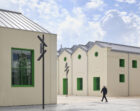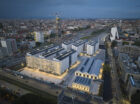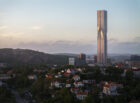Built to house athletes of the 2026 Winter Olympics, the Village will become student housing integrated into the city of Milan after the games
Last week, Skidmore, Owings & Merrill (SOM) and COIMA SGR (COIMA), Italy’s leading real estate developer and investor, celebrated the completion of the 2026 Winter Olympics Athletes’ Village in Porta Romana, Milan and delivered the project to the Milano Cortina Foundation for final preparations ahead of the start of the 2026 Winter Games.
Completed in just 30 months and delivered 30 days ahead of schedule, the Porta Romana Olympic Village leverages a rare opportunity to create a sustainable, intergenerational, and green community in the heart of Milan’s dynamic Porta Romana district. Designed first and foremost to become an integral part of Milan’s urban fabric, the village encompasses a set of public green spaces, the transformation of two historic structures, and six new residential buildings that will serve Olympic athletes short term and subsequently transition into Italy’s largest affordable student-housing development to address a chronic shortage of student beds.

Following the games, the conversion to a 1,700-bed student accommodation scheme will be completed in just four months, ensuring it is ready for the 2026/27 academic year. Likewise, the Olympic Village Plaza will become a vibrant neighborhood square, with shops, bars, restaurants, and cafes at street level, as well as outdoor spaces for farmers’ markets and community events.
“We were compelled by the opportunity to design a project that is purpose built for one usage, and that then will transform for another permanent purpose—and to do so in the most sustainable and urbanistically responsible way possible,” said Partner Colin Koop. “Ultimately, the village will become a vibrant, self-sustaining neighborhood built around principles of social equity, environmental commitment, wellness, inclusivity, and resilience.”

Said Manfredi Catella, Founder and CEO of COIMA, “The Olympic Village sets a new benchmark for sustainability—not just in terms of its low environmental impact, but for its enduring legacy after the Games, when it will provide high-quality, affordable housing for students. It also represents the first building block of the wider Scalo Romana neighborhood, which will transform one of Milan’s historic transport hubs into a vibrant and resilient community for future generations.”
Located on the site of a former rail yard, the Olympic Village takes architectural inspiration from the site’s industrial history, as well as the building typologies of Milan. The site plan adopts the rhythm of the surrounding streetscape, creating a porous urban block with a variety of new public pathways and connections to additional components of the Porta Romana Railway Area Master Plan. The preserved historic structures and ground floor of the residential buildings will house a variety of cultural and economic anchors that serve both residents and visitors, enhancing the tapestry of ground floor experiences that define the urban landscape of Milan.


The new buildings reinterpret the neighborhood’s familiar linear bar typology with a fresh precision, by pairing it with a material palette that is at once contextual and resolutely contemporary. Bookending the campus, communal terraces act as connective bridges—both physically and socially—to establish a new form of shared infrastructure, one rooted as much in human connection as in environmental performance. Shaded by vertical plantings, these terraces will become signature gathering spaces and outdoor study rooms for students, lending the complex a sense of energy and life on every level. The terraces will help buffer the private residential units from the busy streets and public spaces at the edges of the site. Integration of greenery for the outdoor areas is key to the neighborhood’s climate resilience, as well as for the comfort, health, and wellbeing of the occupants and visitors.
At the base of the new buildings, flexible podiums accommodate programs that evolve with the use of the village—just as historic palazzos throughout Italy have provided users with the flexibility to adapt to new uses over time. The porous ground floor with connected alleyways and urban pockets encourages exploration and experiences that create unexpected moments. During the Olympics, these spaces will house recreational and support areas for the athletes. After the games, they will transform into student amenities and public programs, curated as three “districts” forming anchors at the corners of the site: The Scene for media and culture events, The Social for coworking and flexible social spaces, and Live Well for fitness and wellness.

The historic Ex Squadra Rialzo Building and Basilico Building are located adjacent to Via Giovanni Lorenzini on the southwestern corner of the site. Both buildings were built for industrial uses and similarly lend themselves to flexible, public programs. Together, they form a gateway to the complex and establish the importance of the area’s history. The exterior envelope and roofs of both buildings will be fully restored, and their interior structures of masonry, wood, and iron will be exposed, illustrating the neighborhood’s transformation from industrial center to contemporary urban district. Dramatic yet respectful interventions within the buildings’ interiors, like new timber roofs, mechanical systems, infrastructure for restaurant and community space, and art pieces, may also be undertaken.
Sustainability is at the core of the approach to the design and construction. The entire Olympic Village is designed according to the principles of a smart and sustainable city, creating a complex that is at once connected and self-sufficient. The village’s mechanical systems will tie in to the precinct’s loops, yet passive cooling strategies, solar panels, and rooftop gardens—among other features—will ensure that the complex avoids energy waste and generates much of what it consumes on site. In addition, the new buildings maximize the use of sustainable materials, from the mass timber structure of the residential buildings to low-embodied carbon facade materials.





